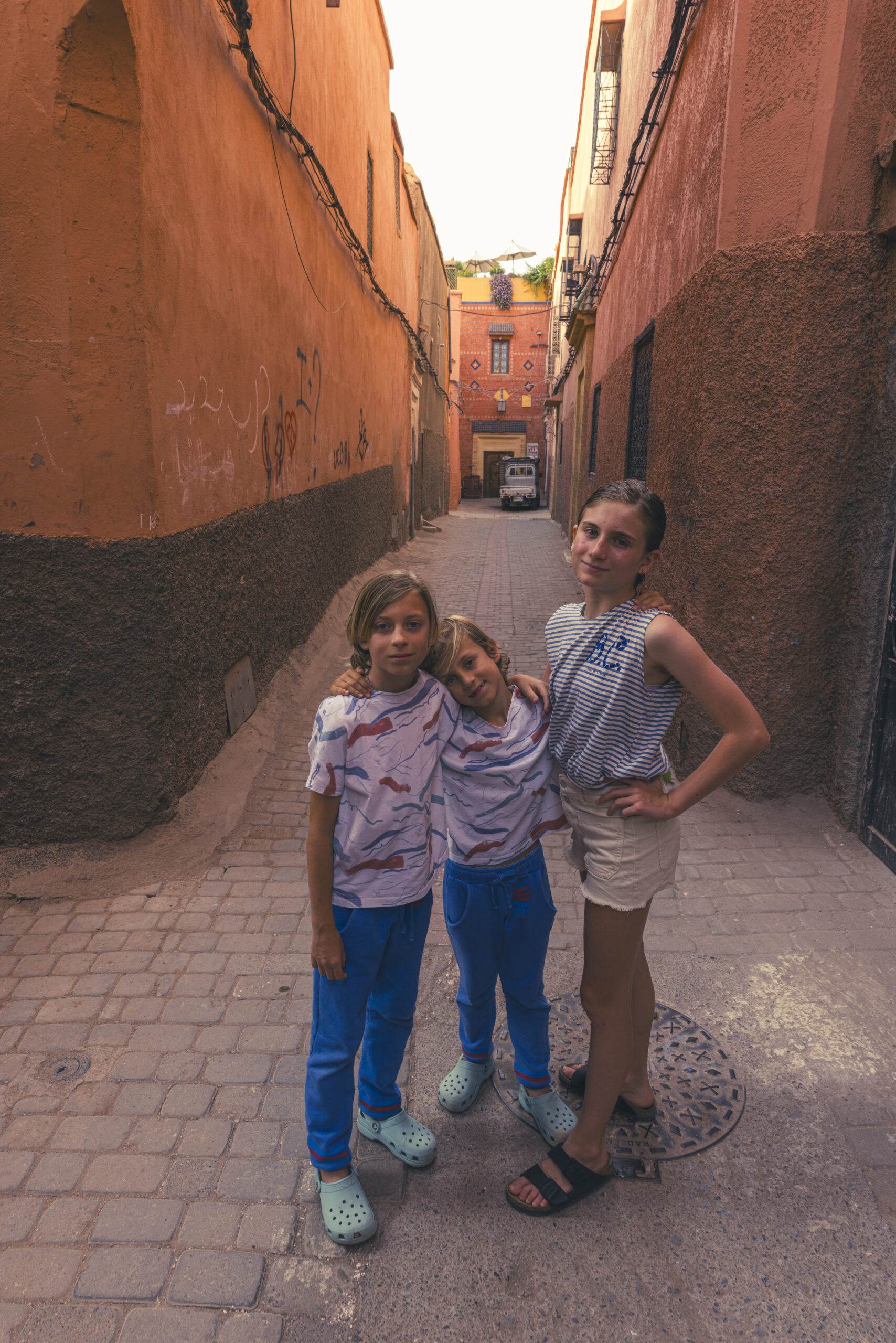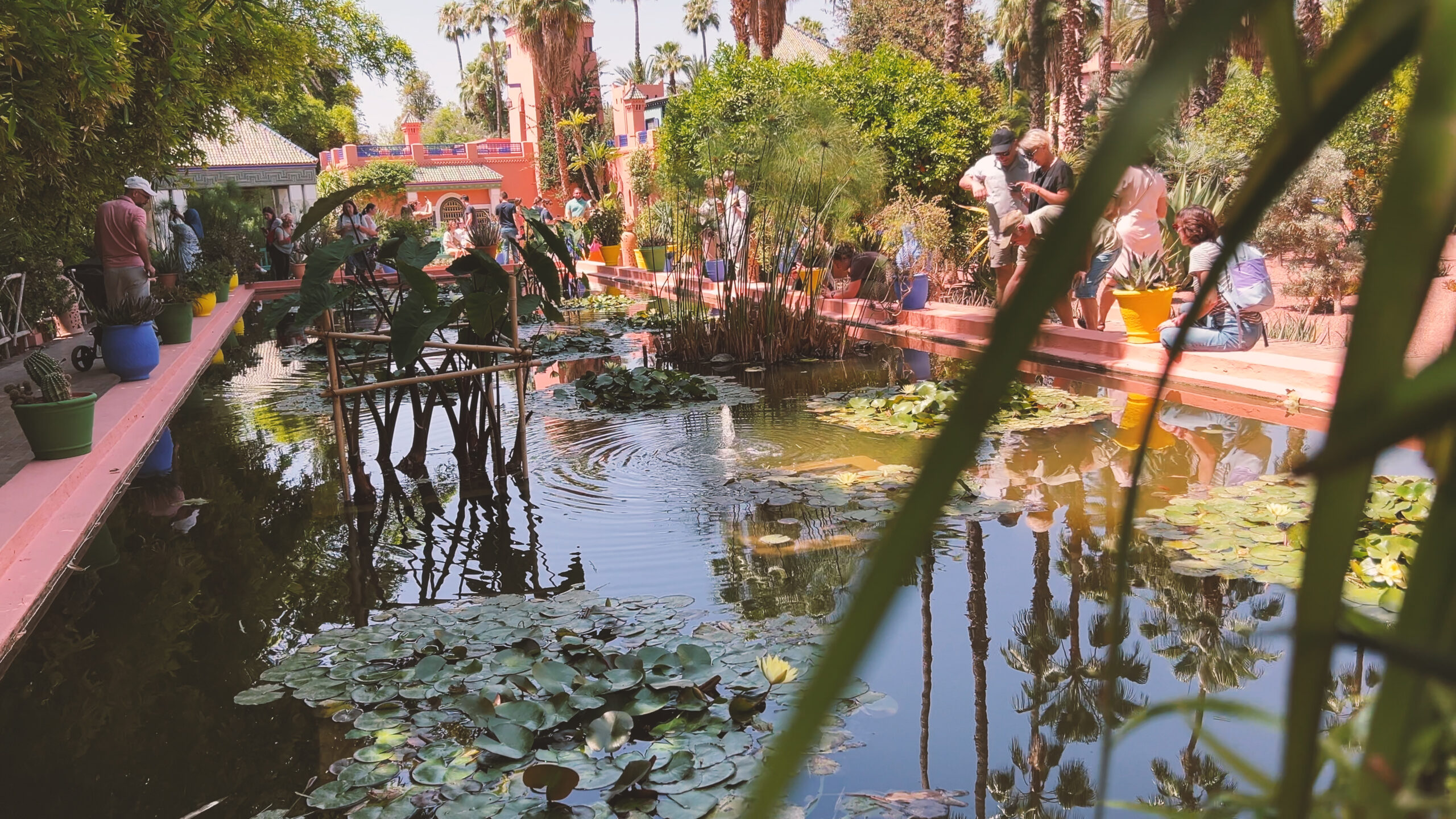Why Spain is a great place for kids
Choosing the city that's right for you
Choosing the visa that's right for you
More than just great weather
Why Spain provides a better quality of life

How we Plan

What we pack
Choosing Travel Insurance
Book Your Hotel
with Booking.com
Book Your Car
with RentalCars.com
Book Your Flight
with Skyscanner.com
Book Your Tour
with GetYourGuide.com

Our Camera Gear

How We Fly
Choosing Your Destination
Top 20 Things to Do in...
Marrakesh
A Family-Friendly Adventure in the Red City
- Medina
- Koutoubia Mosque
- Bahia Palace
- Saadian Tombs
- Majorelle Garden
- Cooking Class
- Ben Youssef Madrasa
- Museum of Marrakesh
- Palm Grove
- Menara Gardens
- Atlas Mountains
- Yves Saint Laurent Museum
- Bab Agnaou
- Hot Air Balloon Ride
- Maison De La Photography
- Dar Si Said
- Boucharouite Museum
- Moroccan Hammam
- Cyber Park
- Fantasia Show

Introduction
Marrakesh, the vibrant and exotic heart of Morocco, is a city that captivates the senses and ignites the imagination. With its labyrinthine medina, bustling souks, and enchanting gardens, Marrakesh offers a treasure trove of experiences for families seeking an unforgettable adventure. From exploring ancient palaces and savoring delicious Moroccan cuisine to embarking on thrilling desert escapades, this city has something for every age and interest. Join us as we unveil the top 20 things to do in Marrakesh, tailored especially for families looking to immerse themselves in the magic of this alluring destination.
Brief History
Founded in 1062 by the Almoravid dynasty, has long been a significant religious, cultural, and trading center in Morocco. The city’s strategic location at the crossroads of ancient caravan routes from Timbuktu to the Mediterranean Sea contributed to its growth and prosperity. Over the centuries, Marrakesh has been ruled by various dynasties, each leaving their mark on the city’s architecture, art, and culture.
Today, Marrakesh is a UNESCO World Heritage Site, renowned for its stunning architecture, vibrant arts scene, and unique blend of Berber, Arab, and European influences. With its timeless charm and endless attractions, the city beckons families to embark on an unforgettable journey through history and culture.

Marrakesh or Marrakech?
In English, the spelling is “Marrakesh.” However, “Marrakech” (the French and Spanish spelling) is frequently used, which adds to the confusion. To continue, the name is officially spelled Mṛṛakc in the Berber Latin alphabet and Marraquexe in Portuguese,
1. Explore the Medina
The heart of Marrakesh is its ancient medina, a walled city dating back to the 11th century. This labyrinthine network of narrow streets and alleys is a treasure trove of sights, sounds, and smells that will captivate the entire family. Wander through the bustling souks, where artisans display their wares, from colorful textiles and intricate pottery to aromatic spices and glittering jewelry.
Kids will love the thrill of getting lost in the maze-like streets, discovering hidden courtyards, and (maybe?) haggling for souvenirs. Be sure to visit the Souk des Teinturiers, where you can watch dyers at work, creating vibrant hues using traditional techniques. For a sweet treat, stop by the Mechoui Alley, where vendors sell delicious slow-roasted lamb and freshly squeezed orange juice.
Tip: Hire a local guide to help you navigate the medina and provide insights into its rich history and culture.





2. Visit The Koutoubia Mosque

The Koutoubia Mosque, with its iconic 77-meter-high minaret, is the largest and most famous mosque in Marrakesh. Built in the 12th century by the Almohad dynasty, this stunning example of Moorish architecture is a must-see for any visitor to the city.
While non-Muslims cannot enter the mosque, families can admire its exquisite exterior, with its intricate brickwork, colorful tilework, and ornate arches. The mosque’s surrounding gardens, with their palm trees, orange groves, and fountains, provide a peaceful respite from the bustle of the medina.
Tip: Visit the Koutoubia Mosque at sunset to see its minaret illuminated against the colorful sky and hear the haunting call to prayer.
3. Discover the Bahia Palace
The Bahia Palace, built in the late 19th century, is a stunning example of Moroccan architecture and craftsmanship. This opulent palace, with its lush gardens, intricate woodwork, and colorful mosaics, was designed to be the greatest palace of its time.




4. Marvel at the Saadian Tombs
The Saadian Tombs, dating back to the 16th century, are a stunning example of Moorish architecture and a testament to the wealth and power of the Saadian dynasty. This elaborate mausoleum, with its intricate carvings, colorful mosaics, and Italian marble, was hidden for centuries until its rediscovery in 1917.
Tip: Combine your visit to the Saadian Tombs with a stop at the nearby Kasbah Mosque and the Bab Agnaou gate for a fuller understanding of the city’s history.
5. Get Lost in the Majorelle Garden
The Majorelle Garden, created by French painter Jacques Majorelle in the 1920s and later restored by fashion designer Yves Saint Laurent, is a lush oasis in the heart of Marrakesh. This enchanting garden, with its cobalt blue buildings, exotic plants, and tranquil pools, is a feast for the senses and a welcome respite from the city’s heat and noise.

Families can stroll through the garden’s shaded paths, admiring the colorful bougainvillea, towering cacti, and fragrant jasmine. Kids will love spotting the garden’s resident turtles and koi fish, while adults can visit the Berber Museum, which houses a collection of traditional Berber artifacts and clothing.
Tip: Visit the garden early in the morning or later in the afternoon to avoid the crowds and enjoy a more peaceful experience.


6. Cooking Class
Many restaurants and culinary schools in Marrakesh offer family-friendly cooking classes, where you can learn to make traditional dishes such as tagine, couscous, and pastilla. Kids will love getting their hands dirty, kneading dough, and mixing spices, while adults can learn about the history and techniques behind each dish.

7. Explore the Ben Youssef Madrasa
The Ben Youssef Madrasa, founded in the 14th century, was once the largest Islamic educational institution in North Africa. Today, this stunning example of Moroccan architecture and craftsmanship is open to the public, offering a glimpse into the country’s rich educational and religious heritage.
Families can explore the madrasa’s many rooms and courtyards, each adorned with intricate stucco work, colorful mosaics, and ornate cedar carvings. Kids will be amazed by the building’s maze-like structure and the stories of the scholars who once studied there.
Tip: Visit the madrasa in the morning or late afternoon to avoid the heat and the crowds, and don’t forget to look up to admire the stunning ceiling carvings.
8. Discover the Museum of Marrakesh
The Museum of Marrakesh, housed in the beautifully restored 19th-century Dar Menebhi Palace, offers a fascinating glimpse into the city’s rich history and culture. The museum’s collection includes traditional Moroccan art and crafts, such as pottery, textiles, and jewelry, as well as historical artifacts and photographs.
9. Palm Grove
Enjoy a Camel Ride in the Palm Grove No visit to Marrakesh would be complete without a camel ride in the city’s lush palm grove, known as the Palmeraie. This vast oasis, with its towering palm trees, green fields, and traditional Berber villages, offers a peaceful escape from the city’s hustle and bustle.
10. Explore Menara Gardens
The Menara Gardens, located at the foot of the Atlas Mountains, are a stunning example of traditional Moroccan landscaping and irrigation techniques. These lush gardens, with their olive groves, fruit orchards, and reflecting pool, have been a popular retreat for locals and visitors alike for centuries.
Tip: Visit the gardens in the late afternoon to enjoy the golden light and cooler temperatures, and don’t forget to bring a picnic to enjoy by the pool.
11. Atlas Mountains
Many tour companies offer guided day trips to the Atlas Mountains, with activities such as hiking, mountain biking, and visiting Berber villages. Kids will love the thrill of exploring the rugged terrain and meeting local children, while adults can admire the stunning scenery and learn about Berber culture and traditions.
12. Visit The Yves Saint Laurent Museum
The Yves Saint Laurent Museum, located next to the Majorelle Garden, is a must-see for fashion lovers and art enthusiasts. This stunning museum, opened in 2017, showcases the life and work of the iconic French fashion designer, who fell in love with Marrakesh and drew much of his inspiration from the city’s colors and culture.
Families can explore the museum’s extensive collection of Saint Laurent’s designs, sketches, and photographs, as well as learn about his creative process and his connection to Marrakesh. Kids will love the interactive exhibits and the colorful displays, while adults can admire the stunning architecture and the designer’s legacy.
13. Explore the Bab Agnaou
The Bab Agnaou, one of the 19 gates of Marrakesh, is a stunning example of Almohad architecture and craftsmanship. This 12th-century gate, with its intricate stone carvings and ornate arches, was once the main entrance to the Kasbah, the city’s royal citadel.
Families can admire the gate’s exquisite details and learn about its history and significance, as well as explore the nearby Kasbah Mosque and the Saadian Tombs. Kids will love playing in the small square in front of the gate, while adults can shop for souvenirs and local crafts.
14. Hot Air Balloon Ride
Take a Hot Air Balloon Ride For a truly unforgettable experience, take your family on a hot air balloon ride over the Marrakesh countryside. Many tour companies offer sunrise or sunset flights, providing stunning views of the city, the palm groves, and the Atlas Mountains.
Tip: Choose a reputable tour company with experienced pilots and safety equipment, and be sure to book in advance as flights can fill up quickly.
15. Visit the Maison de la Photographie
The Maison de la Photographie, located in the heart of the medina, is a must-see for photography enthusiasts and history buffs. This small but fascinating museum showcases a collection of over 10,000 photographs documenting life in Morocco from the 1870s to the 1950s.
16. Explore The Dar Si Said Museum
The Dar Si Said Museum, housed in a stunning 19th-century palace, is a must-see for families interested in Moroccan art and culture. The museum’s collection includes traditional textiles, pottery, jewelry, and musical instruments, as well as exhibits on Moroccan architecture and decorative arts.
17. Visit The Boucharouite Museum
18. Moroccan Hammam
Take a Moroccan Hammam No visit to Marrakesh would be complete without experiencing a traditional Moroccan hammam, or steam bath. This ancient ritual, which involves steaming, scrubbing, and massaging the body, is a beloved part of Moroccan culture and a must-do for families seeking relaxation and rejuvenation.
Many riads and spas in Marrakesh offer family-friendly hammam experiences, with separate areas for men and women and gentle treatments for children. Kids will love the novelty of the experience and the feeling of being pampered, while adults can unwind and let the stress of travel melt away. We chose a place called Isis. It was probably the highlight of our time in Marrakesh.



19. Visit The Cyber Park
Tip: Don’t miss the park’s small museum, which showcases the history of Moroccan gardens and the importance of green spaces in Islamic culture.
